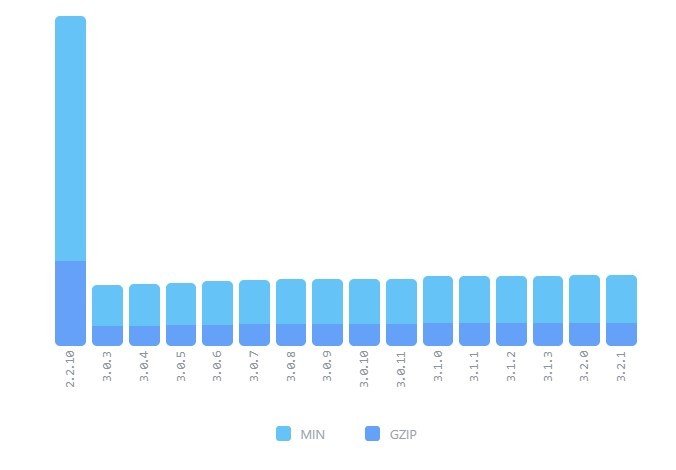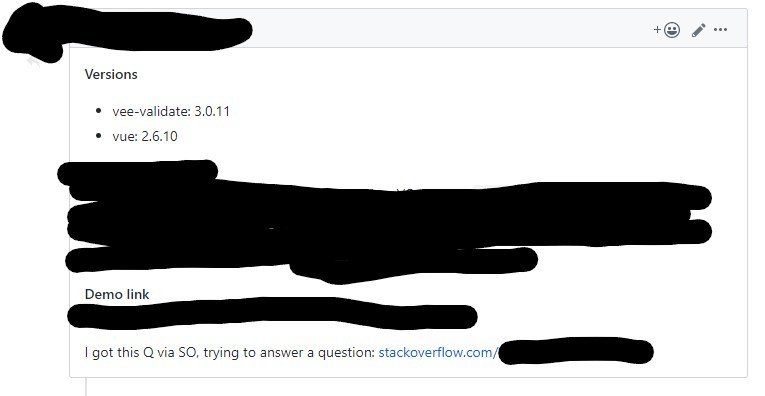My Experience Creating Open-Source

Abdelrahman Awad
Frontend Engineer @Robusta Studio
Open-source contributor and creator of vee-validate
Hello!

VeeValidate
An open-source library for Vue.js that offers client-side validation
| GH Stars | Monthly Downloads | Releases | Commits |
|---|---|---|---|
| 7,100 | 530,000 | 134 | 3,148 |
Stats
How did it begin?
Early 2016
Early 2016 Code
function updateMessage(el, vm) {
vm.errors = Object.assign({}, vm.errors, {
[el.name]: el.validationMessage
});
}
export const ValidateMixin = {
data: () => ({
errors: {}
}),
computed: {
hasErrors() {
// Check if we have errors.
return Object.keys(this.errors).some(key => {
return !!this.errors[key];
});
}
},
directives: {
validate: {
bind(el, _, vnode) {
const vm = vnode.context;
el.addEventListener("input", e => {
updateMessage(e.target, vm);
});
vnode.context.$on("validate", () => {
updateMessage(el, vm);
});
}
}
},
methods: {
validate() {
this.$emit("validate");
}
}
};

So I searched for a package in Vue.js ecosystem that satisfied my needs
There was `vue-validator` but it wasn't actively maintained due to the author working on vue-i18n.
So I decided to build one
Decide the Target Audience
Also called the "Niche market"
Lesson #1
Target Audience
- Backend Laravel Developers
- Beginner JavaScript skills
I didn't plan that, I learned that after the fact
Decide the MVP
- Custom Rule Validation.
- As much as Laravel rules as possible.
- Support all HTML5 input types.
- Asynchronous Validation.
- Cross-field validation.
Lesson #1: Revised
And it wasn't easy
Vue.js lifecycle
ES6 Promises
And of course....
Vue.js Reactivity
Input Events
Prototypes
Vue.js Rendering Mechanism
JavaScript concurrency















- Easily extendable (userland-driven ecosystem)
- Small API surface (Easier to learn and maintain)
API Considerations
⛔
⛔
Lesson #2
What makes React ecosystem so vibrant?
Small API surface area
React at its simplest level is a rendering layer/organization tool, it lets you describe your application in the form of simple primitives called components
How did I got indebted to a large API
Accepted Every New Feature PR
Implemented every feature-request
I was happy everyone was using my library and I intended to keep it that way, that affected how I see things and cost me a lot down the line
Trying to do 100%
Bundle size went from 55kb to 178kb in under a year
It stayed hovering around that size for another year
So I slowed everyone's apps for around:
1.02s
2G
0.62s
3G

Bundling
Webpack: Most Popular
Rollup: Was relatively New
Rolling your own bundler with Babel
Browserify: Very limited
Lesson #3
(function webpackUniversalModuleDefinition(root, factory) {
if(typeof exports === 'object' && typeof module === 'object')
module.exports = factory();
else if(typeof define === 'function' && define.amd)
define([], factory);
else if(typeof exports === 'object')
exports["VeeValidate"] = factory();
else
root["VeeValidate"] = factory();
})(this, function() {
return /******/ (function(modules) { // webpackBootstrap
/******/ // The module cache
/******/ var installedModules = {};
/******/ // The require function
/******/ function __webpack_require__(moduleId) {
/******/ // Check if module is in cache
/******/ if(installedModules[moduleId])
/******/ return installedModules[moduleId].exports;
/******/ // Create a new module (and put it into the cache)
/******/ var module = installedModules[moduleId] = {
/******/ i: moduleId,
/******/ l: false,
/******/ exports: {}
/******/ };
/******/ // Execute the module function
/******/ modules[moduleId].call(module.exports, module, module.exports, __webpack_require__);
/******/ // Flag the module as loaded
/******/ module.l = true;
/******/ // Return the exports of the module
/******/ return module.exports;
/******/ }
/******/ // expose the modules object (__webpack_modules__)
/******/ __webpack_require__.m = modules;
/******/ // expose the module cache
/******/ __webpack_require__.c = installedModules;
/******/ // identity function for calling harmory imports with the correct context
/******/ __webpack_require__.i = function(value) { return value; };
/******/ // define getter function for harmory exports
/******/ __webpack_require__.d = function(exports, name, getter) {
/******/ Object.defineProperty(exports, name, {
/******/ configurable: false,
/******/ enumerable: true,
/******/ get: getter
/******/ });
/******/ };
/******/ // getDefaultExport function for compatibility with non-harmony modules
/******/ __webpack_require__.n = function(module) {
/******/ var getter = module && module.__esModule ?
/******/ function getDefault() { return module['default']; } :
/******/ function getModuleExports() { return module; };
/******/ __webpack_require__.d(getter, 'a', getter);
/******/ return getter;
/******/ };
/******/ // Object.prototype.hasOwnProperty.call
/******/ __webpack_require__.o = function(object, property) { return Object.prototype.hasOwnProperty.call(object, property); };
/******/ // __webpack_public_path__
/******/ __webpack_require__.p = "";
/******/ // Load entry module and return exports
/******/ return __webpack_require__(__webpack_require__.s = 32);
/******/ })
/************************************************************************/
/******/ ([
/* 0 */
/***/ function(module, exports, __webpack_require__) {
"use strict";
console.log('hello world!');

Bundle Size
The cost of running JavaScript

Testing
Lesson #4
Why do we even test?
😎 Confidence
⌚ Backward Compatibility
🐞 Catching Bugs
🤝 For contributors
Testing 101: Terminology
Test Runner
Regression Tests
E2E Tests
Code Coverage
Integration Tests
Unit Tests
Testing Lessons
Coverage is not a goal its a metric

Testing Lessons
Testing Lessons
Start with integration tests
test('listens for input, blur events to set flags', async () => {
const wrapper = mount(
{
data: () => ({
value: ''
}),
template: `
<ValidationProvider rules="required" v-slot="{ errors, ...rest }">
<input v-model="value" type="text">
<li v-for="(flag, name) in rest" v-if="flag" :id="name">{{ name }}</li>
</ValidationProvider>
`
},
{ localVue: Vue, sync: false }
);
const input = wrapper.find('input');
expect(wrapper).toHaveElement('#untouched');
expect(wrapper).toHaveElement('#pristine');
});Testing Lessons
With Pure Unit tests I had 300+ tests with 90% coverage
Right now I have a mix of mostly integration tests and some unit tests with a total of 123 tests with 95% coverage
Some Bugs cannot be tested


Semantic Versioning
3.2.4
Major
💀
Minor
🤩
Patch
😴
Semantic Versioning
Handling Issues
There are 10 types of people
Those who use GitHub issues correctly and those who don't


Non-english Speakers
Stackoverflow Proxies

😱

"Didn't read the docs"

Tips
Be patient, there might be a bug.
Don't be dismissive, be appreciative even if you are going to close the issue/PR
If someone is being rude, make it clear that they are overstepping and close/lock the issue.
Always ask for a reproduction via online sandbox tools or an online repo
Use issue templates and Template replies to save time
RT*M
Reading the manual is one thing, but what about....
WT*M
WT*M #1: Language
Verbosity
Tone
Great read: https://developers.google.com/style
Content
Great read: https://developers.google.com/style
Don't pre-annoucnce stuff
WT*M #2: Structure
Categorize by Topic and Sub-topics

Pictures
Pictures Examples
Great read: https://developers.google.com/style
Always include code snippets and live examples if possible
WT*M #3: Examples
Other stuff
Marketing
Finding Time
Funding
Attracting Contributors